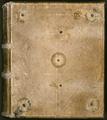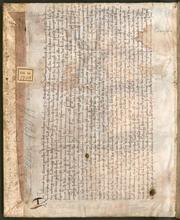File:Freising Gospel Book WDL8921.pdf

Original file (1,550 × 1,741 pixels, file size: 70.92 MB, MIME type: application/pdf, 426 pages)
Captions
Captions
Summary edit
| Title |
Русский: Евангелие Фрайзинга
Français : Évangéliaire de Frisingue
English: Freising Gospel Book
中文:弗莱辛福音书
Português: Livro do evangelho de Freising
العربية: سفر إنجيل فرايسينغ
Español: Evangelio de Freising |
| Description |
Русский: Это Евангелие эпохи Каролингов подчеркивает роль Баварии как места объединения различных художественных традиций. Текст рукописи и выбор прологов соответствуют тем, которые можно найти в старых рукописях Зальцбурга, и могут быть отнесены к итальянскому прототипу. На полях страниц этой великолепной рукописи, написанной во время епископата Анно из Фрайзинга (854—875 гг.), имеются многочисленные критические замечания по тексту, в том числе несколько переводов на греческий. Иные влияния можно наблюдать в оформлении, которое состоит из переплетенных инициалов, 18-страничной последовательности канонов и четырех изображений евангелистов. Влияние школы Каролингов Реймса четко просматривается в эмоциональном стиле живописи на портретах евангелистов. Декоративное украшение рукописи также пропитано различными художественными традициями. В группе родственных манускриптов Евангелия из Фрайзинга эта рукописная книга стоит на первом месте по времени и по качеству. Эпоха Каролингов относится к периоду, в котором большая часть Западной Европы находилась под властью династии, основанной Пипином Коротким в 751 г., сын которого, Карл Великий, получил корону императора Священной Римской империи в 800 г. и правил вплоть до своей смерти в 814 г. Возрождение эпохи Каролингов (около 775—900 гг.) было отмечено достижениями в искусстве, архитектуре, литературе, религии и праве.
Библия; Библия, Новый Завет; Кодекс; Иллюминирование рукописей Français : Cet évangéliaire carolingien illustre la position de la Bavière comme carrefour des différentes traditions artistiques. Le texte et le choix des prologues correspondent à ceux des anciens manuscrits de Salzbourg et dont l’origine peut être liée à un prototype italien. Les marges des feuilles de ce superbe manuscrit, écrit pendant l’épiscopat d’Anno de Frisingue (854-875), contiennent de nombreuses notes critiques sur le texte, y compris une série de variantes grecques. D’autres influences peuvent être observées dans la décoration, qui se compose d’initiales entrelacées, d’une séquence canonique de 18 pages et de quatre illustrations des évangélistes. L’influence de l’école carolingienne de Reims est directement perceptible dans le style de peinture agitée des portraits des évangélistes. De même, la décoration ornementale du manuscrit est caractérisée par une imprégnation de diverses traditions artistiques. Comparé à un groupe de manuscrits d’évangéliaire de Frisingue connexes, ce codex est le plus ancien et le mieux préservé. Le terme « carolingien » fait référence à la période pendant laquelle une grande partie de l’Europe occidentale fut gouvernée par la dynastie établie par Pépin le Bref en 751, dont le fils, Charlemagne, fut couronné empereur du Saint Empire romain en 800 et régit l’empire jusqu’à sa mort en 814. Entre 775 et 900 environ, la renaissance carolingienne fut marquée par des réalisations dans les domaines de l’art, de l’architecture, de la littérature, de la religion et du droit.
Bible; Bible. Nouveau Testament; Codex; Enluminures English: This Carolingian gospel exemplifies the position of Bavaria as a meeting point of different artistic traditions. The text and the choice of prologues correspond with those in older Salzburg manuscripts and can be traced back to an Italian prototype. The marvelous manuscript, written during the episcopate of Anno of Freising (854–75), has in the margins of its leaves numerous critical notes on the text, including a series of Greek variants. Other influences can be observed in the decoration, which consists of interlace initials, an 18-page canon sequence, and four pictures of the evangelists. The influence of the Carolingian school of Rheims is directly discernible in the agitated painting style of the portraits of the evangelists. The ornamental decoration of the manuscript is likewise characterized as being permeated by various artistic traditions. In a group of related Freising gospel manuscripts, this codex comes first both in time and in quality. Carolingian refers to the period in which much of Western Europe was ruled by the dynasty established by Pepin the Short in 751, whose son, Charlemagne, was crowned Holy Roman emperor in 800 and ruled the empire until his death in 814. The Carolingian Renaissance of about 775–900 was marked by achievements in art, architecture, literature, religion, and law.
Bible; Bible. New Testament; Codex; Illuminations 中文:这部卡洛林福音书体现了巴伐利亚作为不同艺术传统交汇点的地位。序言的内容和选择与那些早期的萨尔茨堡手稿一致,可以看到意大利原型的影子。这部杰出的手稿写于弗莱辛安诺(Anno of Freising,854-875 年)主教在位期间,页边空白处有很多对正文的重要注释,包括一系列希腊语版本。从手稿的装饰风格可以看出它受到其它因素的影响,这些装饰包括交错的首字母缩写、18 页按顺序排列的教规以及四幅福音传道者的画像。福音传道者画像极具视觉冲击力,可以明显看出受到兰斯卡洛林学派的影响。手稿的装饰同样极具各式传统艺术特点。在一系列相关的弗莱辛福音手稿中,这部手抄本的年代最早,质量也最佳。卡洛林王朝由矮子丕平 (Pepin the Short) 创立,自公元 751 年开始统治西欧大部分地区。他的儿子查理曼 (Charlemagne) 在公元 800 年被加冕为神圣罗马帝国皇帝,此后一直统治着帝国,直到他于公元 814 年去世。卡洛林文艺复兴大约发生于 775-900 年,在艺术、建筑、文学、宗教和法律方面均取得辉煌成就。
圣经; 圣经新约; 手抄本; 插图 Português: Este evangelho carolíngio exemplifica a posição da Baviera como um ponto de encontro de diferentes tradições artísticas. O texto e a escolha dos prólogos correspondem àqueles nos manuscritos antigos de Salzburgo, e podem ser inicialmente comparados a um protótipo italiano. As margens das páginas do maravilhoso manuscrito, escrito durante o episcopado de Anno de Freising (854–875), apresenta várias notas essenciais sobre o texto, incluindo uma série de variantes gregas. Outras influências podem ser observadas na decoração, composta de iniciais entrelaçadas, uma sequência de cânone de 18 páginas, e quatro imagens dos evangelistas. A influência da escola carolíngia de Rheims é claramente perceptível no estilo de pintura agitado dos retratos dos evangelistas. A decoração ornamental do manuscrito é igualmente caracterizada como sendo permeada por várias tradições artísticas. Em um grupo de manuscritos relacionados aos evangélios de Freising, este códice é o primeiro em questão de tempo e qualidade. O termo carolíngio refere-se ao período no qual boa parte da Europa Ocidental foi dominada pela dinastia criada por Pepino, o Breve, em 751, cujo filho, Carlos Magno, foi coroado imperador Sacro Romano em 800, e dominou o império até sua morte, em 814. A renascença carolíngia (por volta de 775-900) foi marcada por conquistas na arte, arquitetura, literatura, religião e leis.
Bíblia; Bíblia, Novo Testamento; Códice; Iluminuras العربية: يعكس هذا الإنجيل الكارولنجي مكانة بافاريا كنقطة التقاء لضروب مختلفة من التراث الفني. يتوافق النص واختيار المقدمات مع تلك الموجودة في مخطوطات سالزبورغ الأقدم ويمكن إرجاع أصول أسلوبها إلى نموذج إيطالي. تحتوي المخطوطة الرائعة، التي كُتِبَت في عهد الأسقف أنو من فرايسينغ (854–875)، في هوامش صفحاتها على ملاحظات هامة متعددة على النص، بما في ذلك مجموعة من النصوص اليونانية البديلة. هناك تأثيرات أخرى يُمكِن ملاحظتها في الزخرفة، التي تتكون من أحرف أولى متشابكة، وسلسة من القوانين الكنسية المُحتواة في 18 صفحة وأربع صور للمبشرين المسيحيين. يمكن تمييز تأثير مدرسة ريمز الكارولنجية بشكل مباشر من أسلوب رسم لوحات المبشرين المسيحيين المفعم بالحيوية. كذلك تتميز الزخارف المزينة للمخطوطة بالعناصر المتنوعة التي تتخللها وتنتمي إلى ضروب مختلفة من التراث الفني. تأتي هذه المخطوطة على رأس القائمة من حيث الحقبة الزمنية والجودة، وذلك ضمن مجموعة من المخطوطات ذات الصلة في إنجيل فرايسينغ. تشير كلمة كارولنجي إلى الحقبة التي دانَتْ فيها معظم أوروبا الغربية لحُكم الأسرة التي أسّسها بيبين القصير عام 751، والذي تُوِّج ابنه شارلمان إمبراطوراً لروما عام 800 وحَكَم الإمبراطورية حتى وفاته عام 841. تميز عصر النهضة الكارولنجي، في حوالي الفترة ما بين 775–900، بالإنجازات في مجالات الفن والعمارة والأدب والدين والقانون.
الكتاب المقدس; الكتاب المقدس، العهد الجديد; المخطوطات; الزخارف Español: Este evangelio carolingio ejemplifica la posición de Baviera como punto de encuentro de diferentes tradiciones artísticas. El texto y la elección de los prólogos se corresponden con los de los manuscritos más antiguos de Salzburgo y se remontan a un prototipo italiano. El maravilloso manuscrito, escrito durante el episcopado de Anno de Freising (854-875), tiene en los márgenes de sus hojas numerosas notas críticas sobre el texto, incluida una serie de variantes griegas. Se pueden observar otras influencias en la decoración, que consta de iniciales entrelazadas, una secuencia de canon de 18 páginas y cuatro imágenes de los evangelistas. La influencia de la escuela carolingia de Reims se percibe directamente en el estilo de pintura agitado de los retratos de los evangelistas. La decoración ornamental del manuscrito muestra la influencia de diversas tradiciones artísticas. En un grupo de manuscritos relacionados del Evangelio de Freising, este códice está en primer lugar, tanto en tiempo como en calidad. Carolingio se refiere al período en el que gran parte de Europa occidental fue gobernada por la dinastía que estableció Pipino el Breve en el año 751, cuyo hijo, Carlomagno, fue coronado emperador en 800 y gobernó el imperio hasta su muerte en 814. El Renacimiento carolingio de alrededor del 775-900 estuvo marcado por logros en el arte, la arquitectura, la literatura, la religión y la ley.
Biblia; Biblia, Nuevo Testamento; Códice; Iluminaciones |
| Date |
860 date QS:P571,+0860-00-00T00:00:00Z/9 |
| Medium |
Русский: Рукописи
Français : Manuscrits
English: Manuscripts
中文:手稿
Português: Manuscritos
العربية: مخطوطات
Español: Manuscritos |
| Dimensions |
English: 203 sheets, parchment : illustrations ; 28 x 23 centimeters |
| Collection |
Русский: Государственная библиотека Баварии
Français : Bibliothèque d’État de Bavière
English: Bavarian State Library
中文:巴伐利亚州立图书馆
Português: Biblioteca Estatal da Baviera
العربية: مكتبة ولاية بافاريا
Español: Biblioteca Estatal de Baviera |
| Place of creation |
Русский: Фрайзинг
Français : Frisingue
English: Freising
中文:弗莱辛
Português: Freising
العربية: فرايسينغ
Español: Freising |
| Notes |
Original language title: Evangeliarium Русский: Шифр по каталогу Баварской государственной библиотеки: BSB Clm 17011
Français : Cote de la Bibliothèque d’État de Bavière : BSB Clm 17011
English: BSB Shelfmark: BSB Clm 17011
中文:巴伐利亚州立图书馆排架号:BSB Clm 17011
Português: Código BSB: BSB Clm 17011
العربية: علامة الرف في مكتبة ولاية بافاريا: BSB Clm 17011
Español: Signatura BSB: BSB Clm 17011 |
| References | http://hdl.loc.gov/loc.wdl/demnbsb.8921 |
| Source/Photographer |
http://dl.wdl.org/8921/service/8921.pdf
|
Licensing edit
|
This is a faithful photographic reproduction of a two-dimensional, public domain work of art. The work of art itself is in the public domain for the following reason:
The official position taken by the Wikimedia Foundation is that "faithful reproductions of two-dimensional public domain works of art are public domain".
This photographic reproduction is therefore also considered to be in the public domain in the United States. In other jurisdictions, re-use of this content may be restricted; see Reuse of PD-Art photographs for details. | |||||
File history
Click on a date/time to view the file as it appeared at that time.
| Date/Time | Thumbnail | Dimensions | User | Comment | |
|---|---|---|---|---|---|
| current | 17:36, 14 March 2014 |  | 1,550 × 1,741, 426 pages (70.92 MB) | Fæ (talk | contribs) | =={{int:filedesc}}== {{Artwork |artist = |author = |title ={{ru|1=Евангелие Фрайзинга}} {{fr|1=Évangéliaire de Frisingue}} {{en|1=Freising Gospel Book}} {{zh|1=弗莱辛福音书}} {{pt|1=Livro do evangelho de Freising}} {{ar|1=سف... |
You cannot overwrite this file.
File usage on Commons
The following 2 pages use this file:
Metadata
This file contains additional information such as Exif metadata which may have been added by the digital camera, scanner, or software program used to create or digitize it. If the file has been modified from its original state, some details such as the timestamp may not fully reflect those of the original file. The timestamp is only as accurate as the clock in the camera, and it may be completely wrong.
| Image title |
|
|---|---|
| Keywords | This document was downloaded from the World Digital Library (http://www.wdl.org). Go to http://hdl.loc.gov/loc.wdl/wdl.8921 for more information about this item. |
| Date and time of digitizing | 19:20, 11 September 2012 |
| File change date and time | 11:24, 11 September 2012 |
| Date metadata was last modified | 11:24, 11 September 2012 |
| Conversion program | Mac OS X 10.6.8 Quartz PDFContext |
| Encrypted | no |
| Page size |
|
| Version of PDF format | 1.3 |
